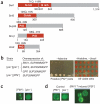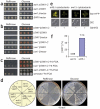Newly identified prion linked to the chromatin-remodeling factor Swi1 in Saccharomyces cerevisiae
- PMID: 18362884
- PMCID: PMC2633598
- DOI: 10.1038/ng.112
Newly identified prion linked to the chromatin-remodeling factor Swi1 in Saccharomyces cerevisiae
Abstract
SWI/SNF, an evolutionarily conserved ATP-dependent chromatin-remodeling complex, has an important role in transcriptional regulation. In Saccharomyces cerevisiae, SWI/SNF regulates the expression of approximately 6% of total genes through activation or repression. Swi1, a subunit of SWI/SNF, contains an N-terminal region rich in glutamine and asparagine, a notable feature shared by all characterized yeast prions--a group of unique proteins capable of self-perpetuating changes in conformation and function. Here we provide evidence that Swi1 can become a prion, [SWI+]. Swi1 aggregates in [SWI+] cells but not in nonprion cells. Cells bearing [SWI+] show a partial loss-of-function phenotype of SWI/SNF. [SW+] can be eliminated by guanidine hydrochloride treatment, HSP104 deletion or loss of Swi1. Moreover, we show [SWI+] is dominantly and cytoplasmically transmitted. Our findings reveal a novel mechanism of 'protein-only' inheritance that results in modification of chromatin-remodeling and, ultimately, global gene regulation.
Figures






References
-
- Martens JA, Winston F. Recent advances in understanding chromatin remodeling by Swi/Snf complexes. Curr. Opin. Genet. Dev. 2003;13:136–142. - PubMed
-
- Tuite MF, Cox BS. Propagation of yeast prions. Nat. Rev. Mol. Cell Biol. 2003;4:878–890. - PubMed
-
- Wickner RB. [URE3] as an altered Ure2 protein: evidence for a prion analog in Saccharomyces cerevisiae. Science. 1994;264:566–569. - PubMed
Publication types
MeSH terms
Substances
Grants and funding
LinkOut - more resources
Full Text Sources
Other Literature Sources
Molecular Biology Databases

